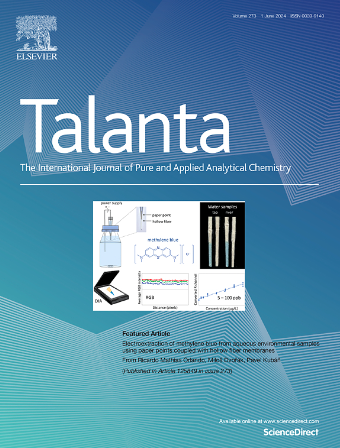合成食品重氮染料亮黑BN (E151)的电化学行为及第一伏安法测定
IF 6.1
1区 化学
Q1 CHEMISTRY, ANALYTICAL
引用次数: 0
摘要
由于合成食品偶氮染料已被证实会导致不良健康问题,因此其含量受到监管,必须严格控制。因此,要确保食品和饮料的质量和安全,就必须有可靠、简单和经济有效的方法来测定它们。本研究报告采用极谱法/循环伏安法,在较宽的 pH 值和扫描速率范围内,系统研究了艳黑 BN(BB BN)在水介质中的电化学行为,BB BN 是一种紫色的合成食品重氮染料,标记为 E151。其中,使用滴汞电极对 BB BN 的电化学还原进行了研究,而使用玻璃碳电极对 BB BN 的氧化进行了研究。重要的是,这项工作介绍了首个测定 BB BN 的伏安法的开发情况,该方法基于在 pH 值为 3.0 的布里顿-罗宾逊缓冲液中,在两种类型的银固体汞合金电极(AgSAE)(如抛光型(p-AgSAE)和汞半月板修饰型(m-AgSAE))上还原 BB BN。结果表明,将线性扫描吸附剥离伏安法与 m-AgSAE 结合使用,可在未搅拌溶液中以 300 秒的累积时间达到 0.12 μM 的检测限。新开发的方法成功地用于直接测定加标自来水、加标软饮料和药品中的 BB BN。根据 "蓝色适用性大指数 "度量工具,该方法得分为72.5分,表明该方法在实用性和适用性方面非常适合。本文章由计算机程序翻译,如有差异,请以英文原文为准。

Electrochemical behavior of the synthetic food diazo dye Brilliant Black BN (E151) and the first voltammetric method for its determination
As synthetic food azo dyes have been proven to cause adverse health problems, their content is regulated and must be strictly controlled. Therefore, the availability of reliable as well as simple and cost-effective methods for their determination is essential to ensure the quality and safety of food and beverages. This work reports on a systematic study of the electrochemical behavior of Brilliant Black BN (BB BN), a purple synthetic food diazo dye, labelled as E151, in aqueous media using polarography/cyclic voltammetry over a wide range of pH and scan rates. In particular, the electrochemical reduction of BB BN was investigated using a dropping mercury electrode, while the BB BN oxidation − using a glassy carbon electrode. Importantly, this work describes the development of the very first voltammetric method for the determination of BB BN, which is based on its reduction in the Britton-Robinson buffer, pH 3.0, at two types of silver solid amalgam electrodes (AgSAEs), such as polished (p-AgSAE) and mercury meniscus modified one (m-AgSAE). The results demonstrated that the linear scan adsorptive stripping voltammetry in combination with m-AgSAE allows to reach a limit of detection of 0.12 μM applying the accumulation time of 300 s in unstirred solution. The newly developed method was successfully utilized for the direct determination of BB BN in spiked tap water, spiked soft drink, and pharmaceuticals. According to the Blue Applicability Great Index metric tool, the proposed method scored 72.5 points, indicating its suitability in terms of practicality and applicability.
求助全文
通过发布文献求助,成功后即可免费获取论文全文。
去求助
来源期刊

Talanta
化学-分析化学
CiteScore
12.30
自引率
4.90%
发文量
861
审稿时长
29 days
期刊介绍:
Talanta provides a forum for the publication of original research papers, short communications, and critical reviews in all branches of pure and applied analytical chemistry. Papers are evaluated based on established guidelines, including the fundamental nature of the study, scientific novelty, substantial improvement or advantage over existing technology or methods, and demonstrated analytical applicability. Original research papers on fundamental studies, and on novel sensor and instrumentation developments, are encouraged. Novel or improved applications in areas such as clinical and biological chemistry, environmental analysis, geochemistry, materials science and engineering, and analytical platforms for omics development are welcome.
Analytical performance of methods should be determined, including interference and matrix effects, and methods should be validated by comparison with a standard method, or analysis of a certified reference material. Simple spiking recoveries may not be sufficient. The developed method should especially comprise information on selectivity, sensitivity, detection limits, accuracy, and reliability. However, applying official validation or robustness studies to a routine method or technique does not necessarily constitute novelty. Proper statistical treatment of the data should be provided. Relevant literature should be cited, including related publications by the authors, and authors should discuss how their proposed methodology compares with previously reported methods.
 求助内容:
求助内容: 应助结果提醒方式:
应助结果提醒方式:


